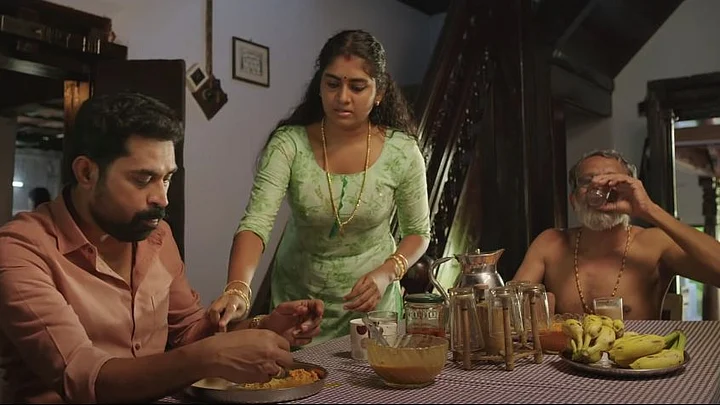In India women are worshipped as goddesses. We literally have a pantheon to depict each virtue. But it’s the domestic goddess avatar that is most revered. Sex goddess may come second, but it’s a second and a very distant second when it comes to open respect.
That is what The Great Indian Kitchen a little gem of a film by writer-director Jeo Baby deftly brings into focus - the rarely discussed matter of the oppressive drudgery within the Indian marriage. The glorification of the domestic chores is almost like the founding stone of this institution.
The very first frame of the movie says ‘Thanks Science’ a homage to all things rational. A light on the absurd irrationality of religion woven into customs and traditions. From then on, the movie hurtles headlong towards smashing facets of patriarchy seldom addressed.
As you watch… you recognise familiar scenarios that leave you squirming or seething, depending on your gender. A new bride following her mother-in-law around the kitchen trying to ‘fit’ in. Men idly hanging out being fed, pampered and every whim catered to. Women eating last, women waking up first, women tired and last to sleep, women expected to have sex because the man chooses, their taken for granted status, their helplessness, the utter refusal of the men to self-introspect about their own boorishness…
Though the film is set in an extremely traditional Nair tharavad house, it is universal in its content. The stellar cast with brilliant two leads Nimisha Sayajan as the new bride and Suraj Venjaramoodu as the husband effortlessly weave the viewer into the tapestry of the cultural trap that is elaborately laid out for women. We become almost complicit in our silence, leaving the film with a strange sense of discomfort.
It’s the subtle nuances that elevate the film and keep it very real and relatable.
- A heroine who remains nameless.
- The kitchen sink that never gets repaired, its stench growing as the characters slip further into the cultural abyss.
- The innocuous usage of a mixi or washing machine as signs of laziness.
- The background silence.
- The eternally hurried pace of the women versus the virtually static state of the men…
The thing about patriarchy is it’s rarely strident, in reality, it’s almost invisible. And that’s the most dangerous aspect of it. You see its menacing undercurrent right through the film.
The bride is no bra burning feminist, in fact, she’s an eager to please docile young woman. The men too are kind and never raise their voices or a hand on the women. This seemingly tender calm is a constricting python.
You can see that the women have little or no choice or chance to get out of that. That ‘decency’ is the prison. The gentleness is the trap. The more silently a woman accepts it all the better a wife, sister, mother she is seen as.
But the worst aspect is the hypocrisy around a woman’s menstrual cycle. To vilify her during those exact days when her body chooses to celebrate her womanhood is peak misogyny. When menstruating, even an upper caste woman is considered a low caste untouchable. Aided and abetted by other women. (Of course, some in the sisterhood gleefully bend these rules, as the servant in the film tells the bride.)
One of the most powerful sequences in the film deals with exactly that. The wife is on her period, accidentally touches her husband who has taken the vow to go to Sabarimala. The priest tells him the only way to purify himself again is to eat cow dung or drink gaumutra. In effect, saying even the waste of a cow is purer than a menstruating woman. But that’s not the beauty of the scene… it’s how the priest nonchalantly reduces the penance to a quick dip in water instead! All the rigour is quite clearly reserved only for the women.
Once some years ago, during a relative’s funeral rituals, I started my period. Suddenly my loving extended family turned into strangers. A separate plate, separate glass, a bed and pillow of straw, my very presence was defiling. I remember the intense shame I felt. It hit me hard that day, the seemingly insurmountable wall of patriarchy. I remember feeling diminished and helpless. But that’s not the half of it… later in the evening a male relative who was key to the events, returned drunk. He sat with his lackey at the exact spot where we conducted the last rites, with a bottle of rum and mutton pepper fry reminiscing about the dear departed. Everyone saw. Everyone knew. And that silence was deafening.
I could escape because that was never my reality. But for most women, as the film shows, it’s not that easy. Men continue to to stay entitled, for woman though, self-respect is a tough lonely road.
To me this was way more than just a film. It’s the closest depiction to real life I’ve seen in a very long time. Take a bow The Great Indian Kitchen!
(Sangita Nambiar is a writer, active theatre person and deep sea diving enthusiast.)
(At The Quint, we question everything. Play an active role in shaping our journalism by becoming a member today.)
